Chanel HRD: Training Initiatives, Competency Movements, and Learning
VerifiedAdded on 2024/05/30
|27
|5376
|144
Report
AI Summary
This report provides a comprehensive overview of human resource development (HRD), focusing on various learning styles, training needs assessment, and the role of government initiatives. It begins by comparing different learning styles based on Kolb's and Honey and Mumford's theories, highlighting the importance of learning transfer within the workplace. The report then compares training needs for staff members with the training needs assessment model, discussing the advantages and disadvantages of different training methods and outlining a systematic approach to planning training events. Furthermore, it evaluates the usefulness of training and feedback, analyzing responses and reviewing the success of the evaluation process. The essay also examines the role of government in training, development, and lifelong learning, assessing the impact of the competency movement on public and private sector organizations and evaluating contemporary training initiatives by the UK government in relation to HRD within an organization, using Chanel as a case study. This document is helpful for students, and Desklib offers a platform with additional study tools and resources.
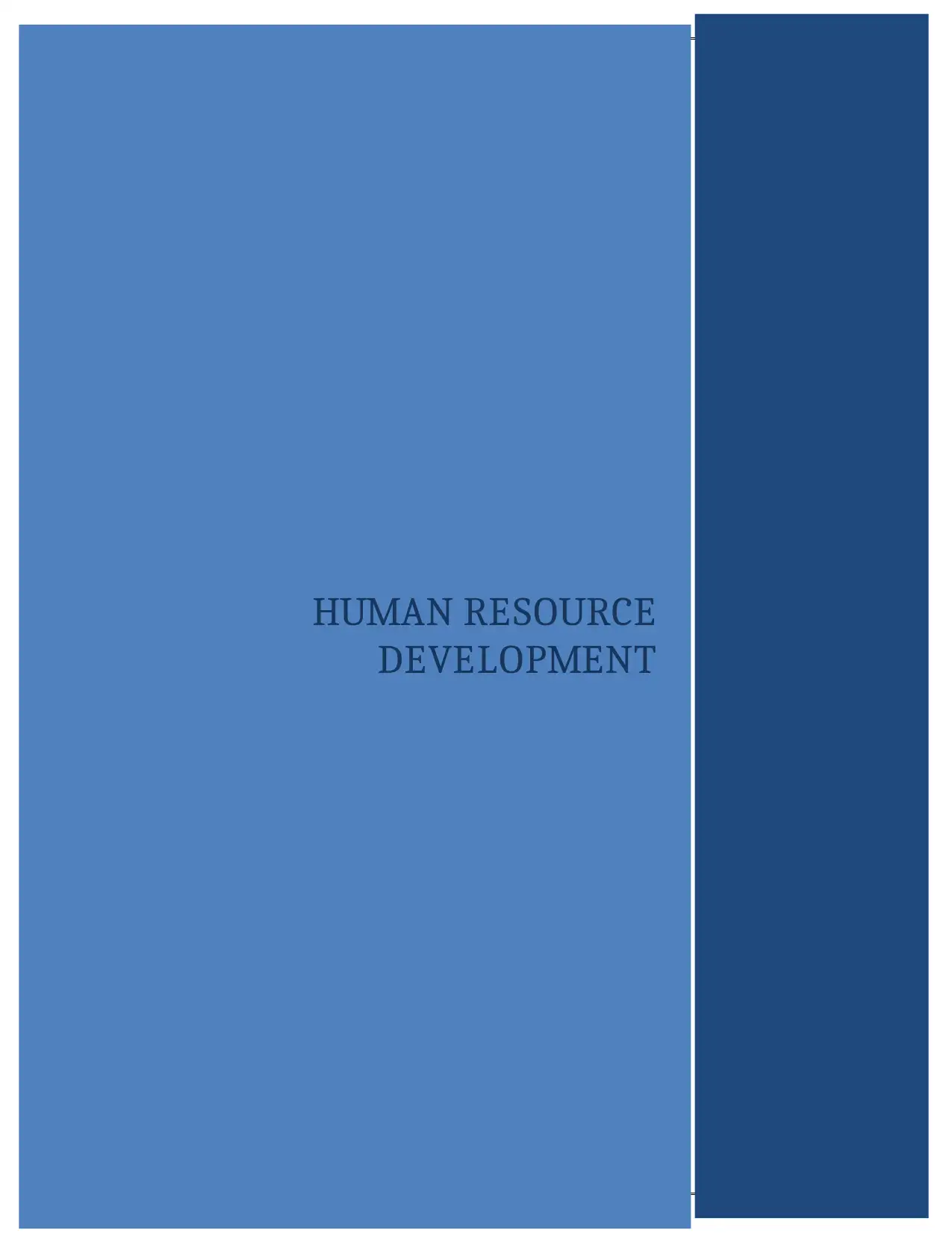
HUMAN RESOURCE
DEVELOPMENT
DEVELOPMENT
Paraphrase This Document
Need a fresh take? Get an instant paraphrase of this document with our AI Paraphraser
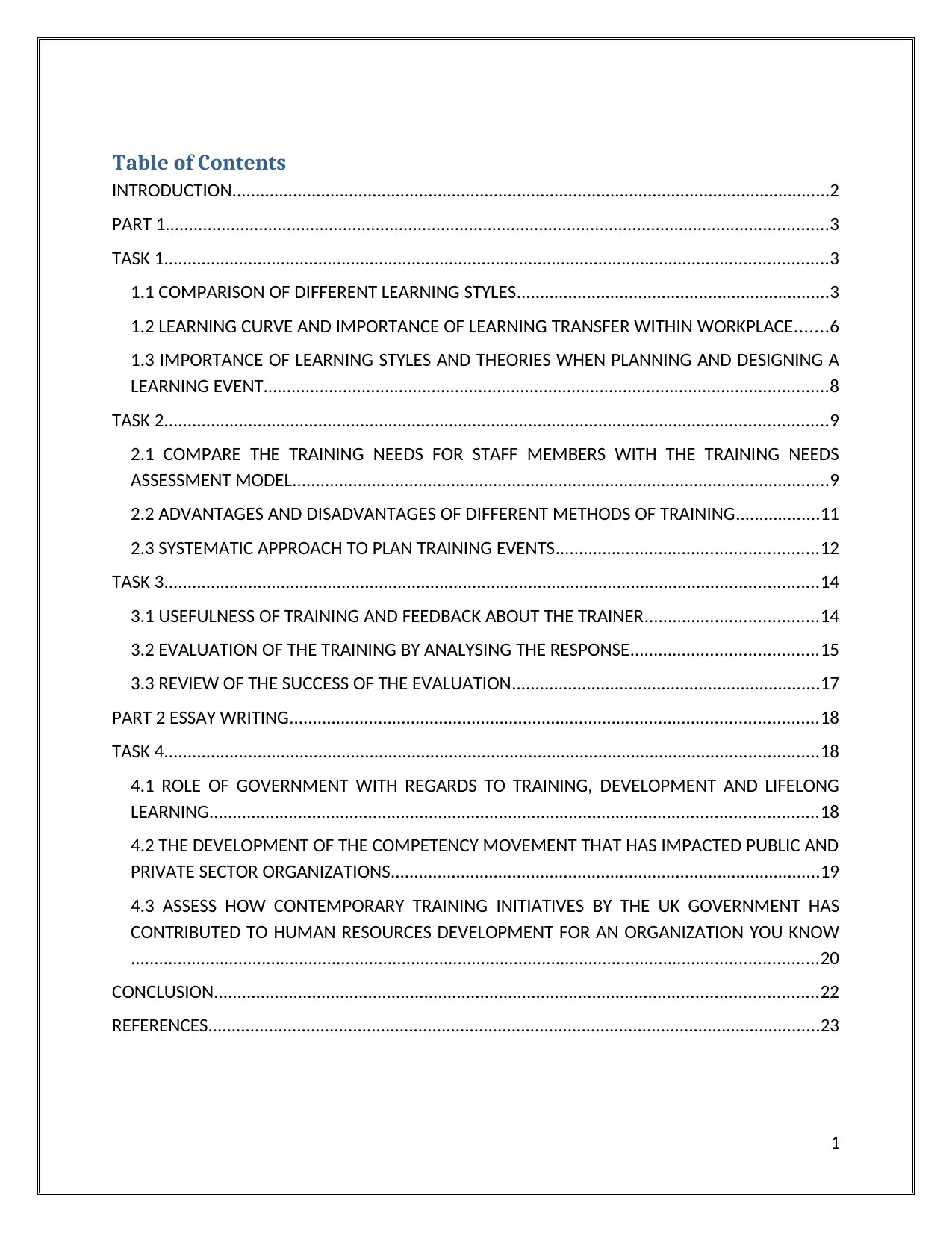
Table of Contents
INTRODUCTION................................................................................................................................2
PART 1..............................................................................................................................................3
TASK 1..............................................................................................................................................3
1.1 COMPARISON OF DIFFERENT LEARNING STYLES...................................................................3
1.2 LEARNING CURVE AND IMPORTANCE OF LEARNING TRANSFER WITHIN WORKPLACE.......6
1.3 IMPORTANCE OF LEARNING STYLES AND THEORIES WHEN PLANNING AND DESIGNING A
LEARNING EVENT.........................................................................................................................8
TASK 2..............................................................................................................................................9
2.1 COMPARE THE TRAINING NEEDS FOR STAFF MEMBERS WITH THE TRAINING NEEDS
ASSESSMENT MODEL...................................................................................................................9
2.2 ADVANTAGES AND DISADVANTAGES OF DIFFERENT METHODS OF TRAINING..................11
2.3 SYSTEMATIC APPROACH TO PLAN TRAINING EVENTS........................................................12
TASK 3............................................................................................................................................14
3.1 USEFULNESS OF TRAINING AND FEEDBACK ABOUT THE TRAINER.....................................14
3.2 EVALUATION OF THE TRAINING BY ANALYSING THE RESPONSE........................................15
3.3 REVIEW OF THE SUCCESS OF THE EVALUATION..................................................................17
PART 2 ESSAY WRITING.................................................................................................................18
TASK 4............................................................................................................................................18
4.1 ROLE OF GOVERNMENT WITH REGARDS TO TRAINING, DEVELOPMENT AND LIFELONG
LEARNING..................................................................................................................................18
4.2 THE DEVELOPMENT OF THE COMPETENCY MOVEMENT THAT HAS IMPACTED PUBLIC AND
PRIVATE SECTOR ORGANIZATIONS............................................................................................19
4.3 ASSESS HOW CONTEMPORARY TRAINING INITIATIVES BY THE UK GOVERNMENT HAS
CONTRIBUTED TO HUMAN RESOURCES DEVELOPMENT FOR AN ORGANIZATION YOU KNOW
...................................................................................................................................................20
CONCLUSION.................................................................................................................................22
REFERENCES...................................................................................................................................23
1
INTRODUCTION................................................................................................................................2
PART 1..............................................................................................................................................3
TASK 1..............................................................................................................................................3
1.1 COMPARISON OF DIFFERENT LEARNING STYLES...................................................................3
1.2 LEARNING CURVE AND IMPORTANCE OF LEARNING TRANSFER WITHIN WORKPLACE.......6
1.3 IMPORTANCE OF LEARNING STYLES AND THEORIES WHEN PLANNING AND DESIGNING A
LEARNING EVENT.........................................................................................................................8
TASK 2..............................................................................................................................................9
2.1 COMPARE THE TRAINING NEEDS FOR STAFF MEMBERS WITH THE TRAINING NEEDS
ASSESSMENT MODEL...................................................................................................................9
2.2 ADVANTAGES AND DISADVANTAGES OF DIFFERENT METHODS OF TRAINING..................11
2.3 SYSTEMATIC APPROACH TO PLAN TRAINING EVENTS........................................................12
TASK 3............................................................................................................................................14
3.1 USEFULNESS OF TRAINING AND FEEDBACK ABOUT THE TRAINER.....................................14
3.2 EVALUATION OF THE TRAINING BY ANALYSING THE RESPONSE........................................15
3.3 REVIEW OF THE SUCCESS OF THE EVALUATION..................................................................17
PART 2 ESSAY WRITING.................................................................................................................18
TASK 4............................................................................................................................................18
4.1 ROLE OF GOVERNMENT WITH REGARDS TO TRAINING, DEVELOPMENT AND LIFELONG
LEARNING..................................................................................................................................18
4.2 THE DEVELOPMENT OF THE COMPETENCY MOVEMENT THAT HAS IMPACTED PUBLIC AND
PRIVATE SECTOR ORGANIZATIONS............................................................................................19
4.3 ASSESS HOW CONTEMPORARY TRAINING INITIATIVES BY THE UK GOVERNMENT HAS
CONTRIBUTED TO HUMAN RESOURCES DEVELOPMENT FOR AN ORGANIZATION YOU KNOW
...................................................................................................................................................20
CONCLUSION.................................................................................................................................22
REFERENCES...................................................................................................................................23
1
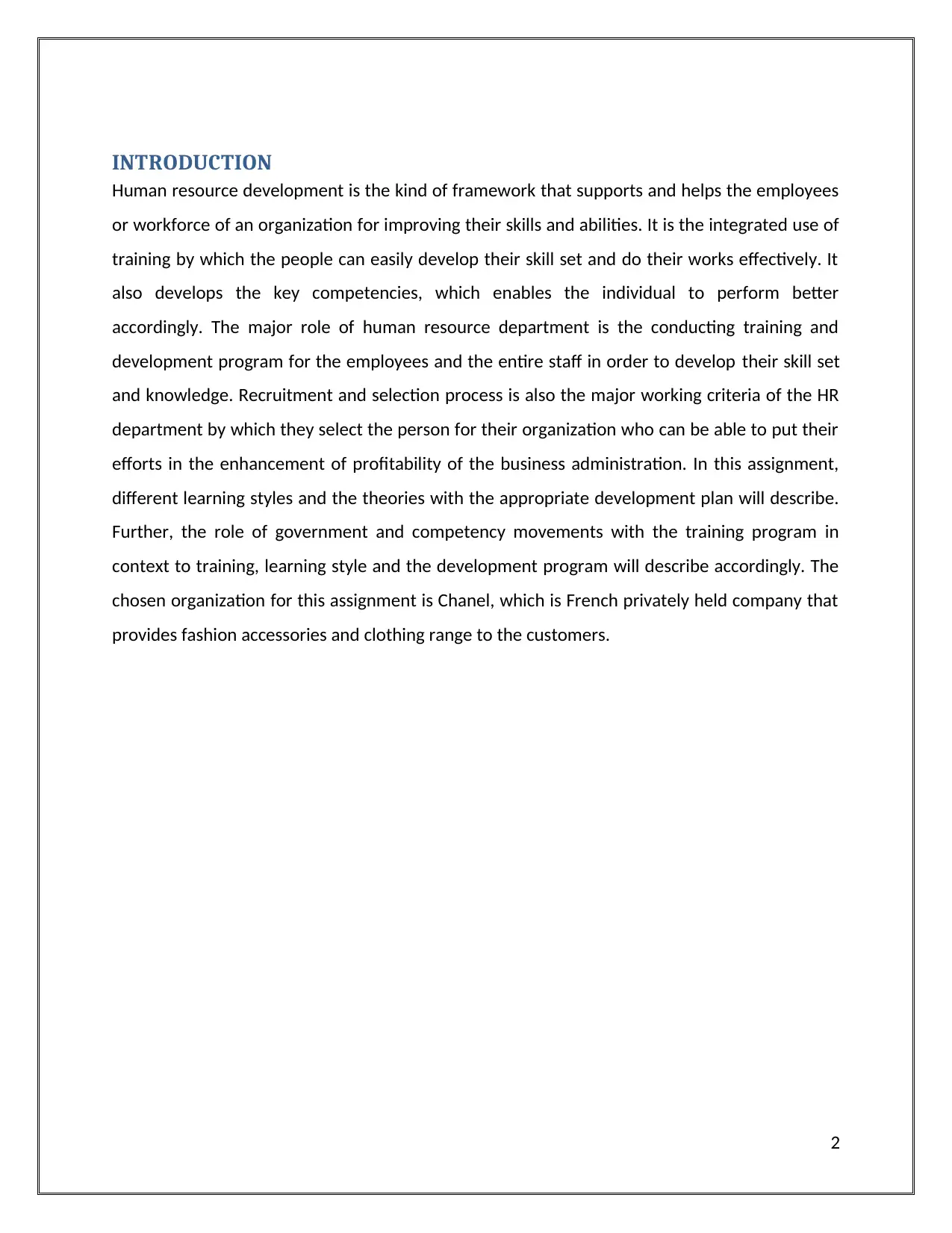
INTRODUCTION
Human resource development is the kind of framework that supports and helps the employees
or workforce of an organization for improving their skills and abilities. It is the integrated use of
training by which the people can easily develop their skill set and do their works effectively. It
also develops the key competencies, which enables the individual to perform better
accordingly. The major role of human resource department is the conducting training and
development program for the employees and the entire staff in order to develop their skill set
and knowledge. Recruitment and selection process is also the major working criteria of the HR
department by which they select the person for their organization who can be able to put their
efforts in the enhancement of profitability of the business administration. In this assignment,
different learning styles and the theories with the appropriate development plan will describe.
Further, the role of government and competency movements with the training program in
context to training, learning style and the development program will describe accordingly. The
chosen organization for this assignment is Chanel, which is French privately held company that
provides fashion accessories and clothing range to the customers.
2
Human resource development is the kind of framework that supports and helps the employees
or workforce of an organization for improving their skills and abilities. It is the integrated use of
training by which the people can easily develop their skill set and do their works effectively. It
also develops the key competencies, which enables the individual to perform better
accordingly. The major role of human resource department is the conducting training and
development program for the employees and the entire staff in order to develop their skill set
and knowledge. Recruitment and selection process is also the major working criteria of the HR
department by which they select the person for their organization who can be able to put their
efforts in the enhancement of profitability of the business administration. In this assignment,
different learning styles and the theories with the appropriate development plan will describe.
Further, the role of government and competency movements with the training program in
context to training, learning style and the development program will describe accordingly. The
chosen organization for this assignment is Chanel, which is French privately held company that
provides fashion accessories and clothing range to the customers.
2
⊘ This is a preview!⊘
Do you want full access?
Subscribe today to unlock all pages.

Trusted by 1+ million students worldwide
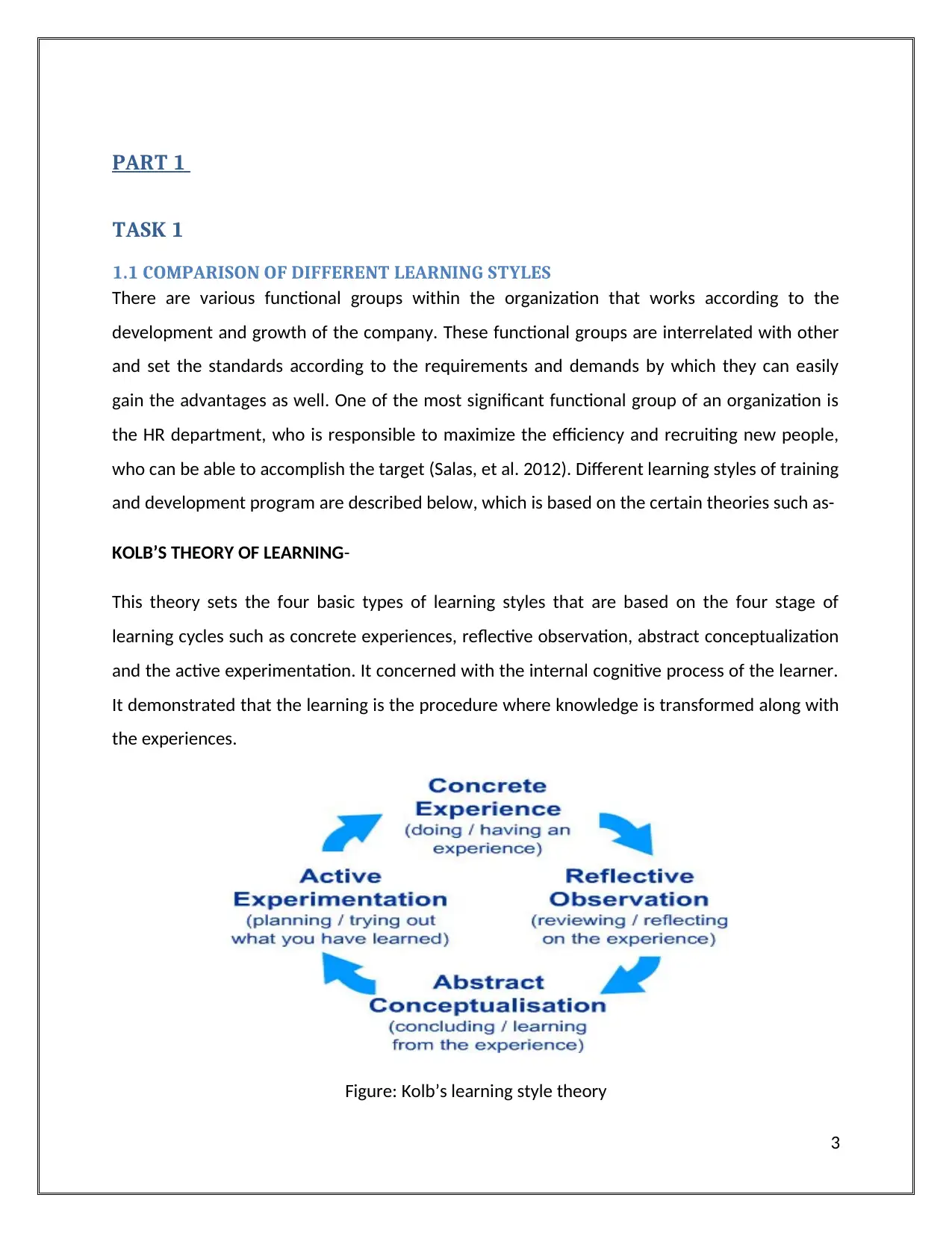
PART 1
TASK 1
1.1 COMPARISON OF DIFFERENT LEARNING STYLES
There are various functional groups within the organization that works according to the
development and growth of the company. These functional groups are interrelated with other
and set the standards according to the requirements and demands by which they can easily
gain the advantages as well. One of the most significant functional group of an organization is
the HR department, who is responsible to maximize the efficiency and recruiting new people,
who can be able to accomplish the target (Salas, et al. 2012). Different learning styles of training
and development program are described below, which is based on the certain theories such as-
KOLB’S THEORY OF LEARNING-
This theory sets the four basic types of learning styles that are based on the four stage of
learning cycles such as concrete experiences, reflective observation, abstract conceptualization
and the active experimentation. It concerned with the internal cognitive process of the learner.
It demonstrated that the learning is the procedure where knowledge is transformed along with
the experiences.
Figure: Kolb’s learning style theory
3
TASK 1
1.1 COMPARISON OF DIFFERENT LEARNING STYLES
There are various functional groups within the organization that works according to the
development and growth of the company. These functional groups are interrelated with other
and set the standards according to the requirements and demands by which they can easily
gain the advantages as well. One of the most significant functional group of an organization is
the HR department, who is responsible to maximize the efficiency and recruiting new people,
who can be able to accomplish the target (Salas, et al. 2012). Different learning styles of training
and development program are described below, which is based on the certain theories such as-
KOLB’S THEORY OF LEARNING-
This theory sets the four basic types of learning styles that are based on the four stage of
learning cycles such as concrete experiences, reflective observation, abstract conceptualization
and the active experimentation. It concerned with the internal cognitive process of the learner.
It demonstrated that the learning is the procedure where knowledge is transformed along with
the experiences.
Figure: Kolb’s learning style theory
3
Paraphrase This Document
Need a fresh take? Get an instant paraphrase of this document with our AI Paraphraser
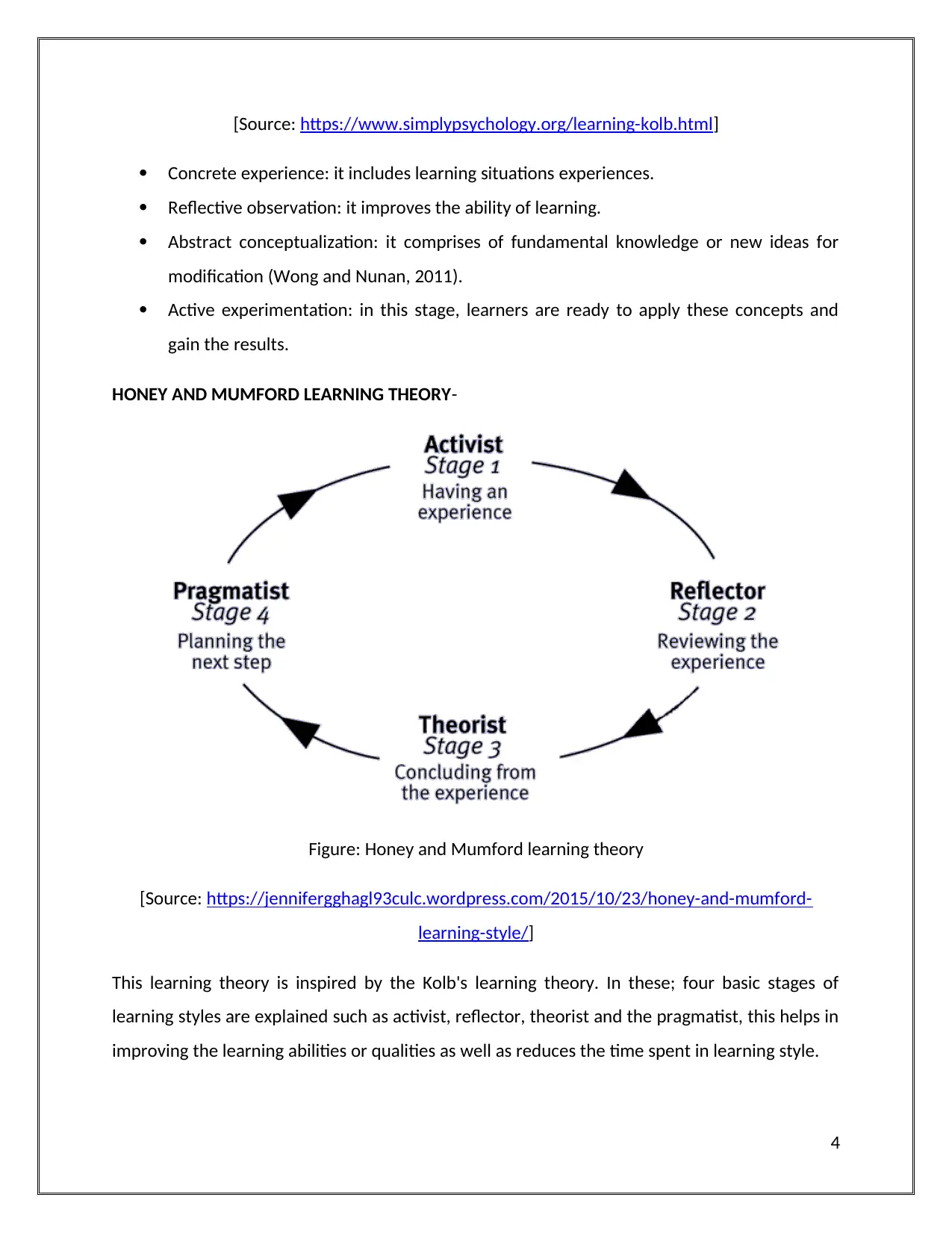
[Source: https://www.simplypsychology.org/learning-kolb.html]
Concrete experience: it includes learning situations experiences.
Reflective observation: it improves the ability of learning.
Abstract conceptualization: it comprises of fundamental knowledge or new ideas for
modification (Wong and Nunan, 2011).
Active experimentation: in this stage, learners are ready to apply these concepts and
gain the results.
HONEY AND MUMFORD LEARNING THEORY-
Figure: Honey and Mumford learning theory
[Source: https://jennifergghagl93culc.wordpress.com/2015/10/23/honey-and-mumford-
learning-style/]
This learning theory is inspired by the Kolb's learning theory. In these; four basic stages of
learning styles are explained such as activist, reflector, theorist and the pragmatist, this helps in
improving the learning abilities or qualities as well as reduces the time spent in learning style.
4
Concrete experience: it includes learning situations experiences.
Reflective observation: it improves the ability of learning.
Abstract conceptualization: it comprises of fundamental knowledge or new ideas for
modification (Wong and Nunan, 2011).
Active experimentation: in this stage, learners are ready to apply these concepts and
gain the results.
HONEY AND MUMFORD LEARNING THEORY-
Figure: Honey and Mumford learning theory
[Source: https://jennifergghagl93culc.wordpress.com/2015/10/23/honey-and-mumford-
learning-style/]
This learning theory is inspired by the Kolb's learning theory. In these; four basic stages of
learning styles are explained such as activist, reflector, theorist and the pragmatist, this helps in
improving the learning abilities or qualities as well as reduces the time spent in learning style.
4
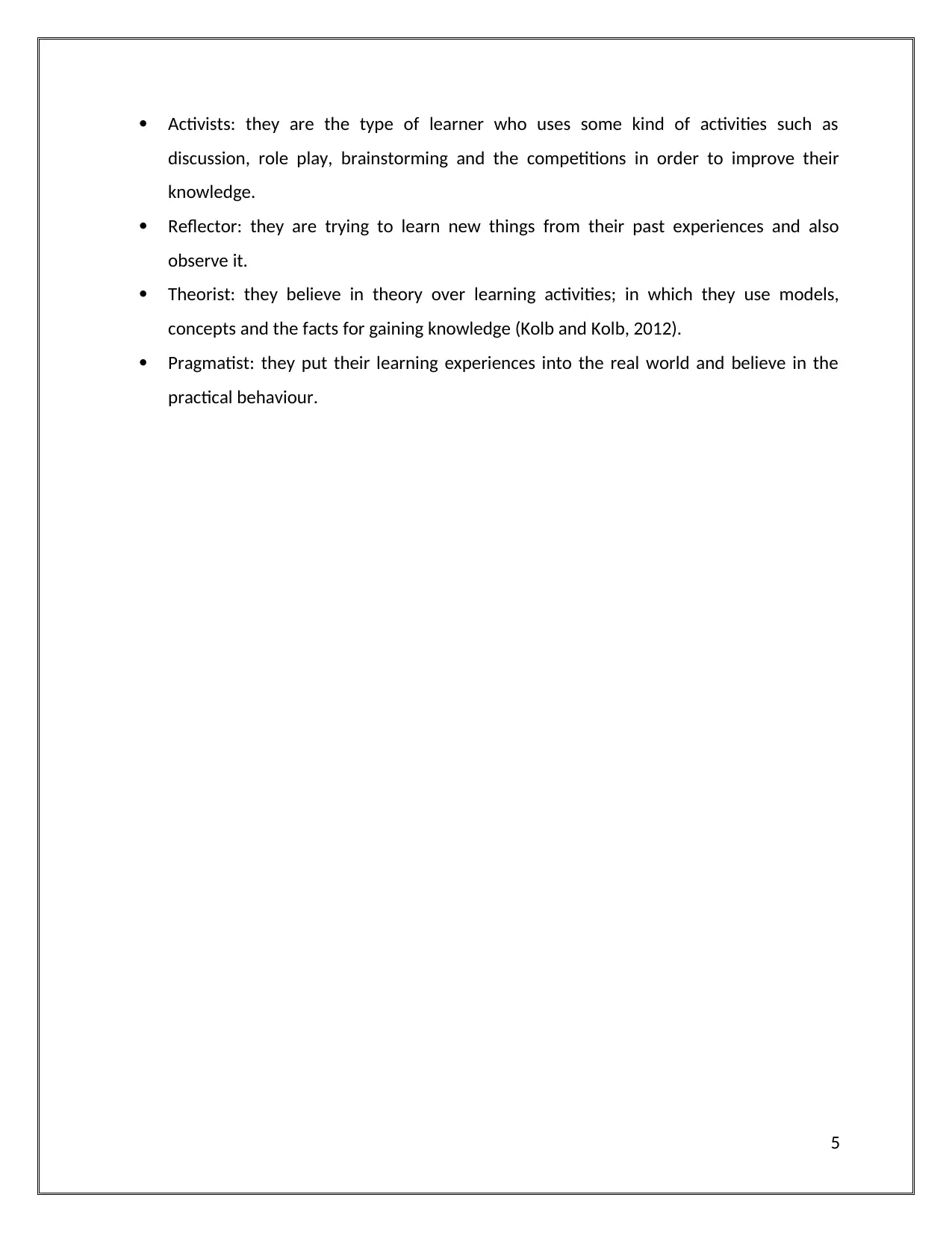
Activists: they are the type of learner who uses some kind of activities such as
discussion, role play, brainstorming and the competitions in order to improve their
knowledge.
Reflector: they are trying to learn new things from their past experiences and also
observe it.
Theorist: they believe in theory over learning activities; in which they use models,
concepts and the facts for gaining knowledge (Kolb and Kolb, 2012).
Pragmatist: they put their learning experiences into the real world and believe in the
practical behaviour.
5
discussion, role play, brainstorming and the competitions in order to improve their
knowledge.
Reflector: they are trying to learn new things from their past experiences and also
observe it.
Theorist: they believe in theory over learning activities; in which they use models,
concepts and the facts for gaining knowledge (Kolb and Kolb, 2012).
Pragmatist: they put their learning experiences into the real world and believe in the
practical behaviour.
5
⊘ This is a preview!⊘
Do you want full access?
Subscribe today to unlock all pages.

Trusted by 1+ million students worldwide
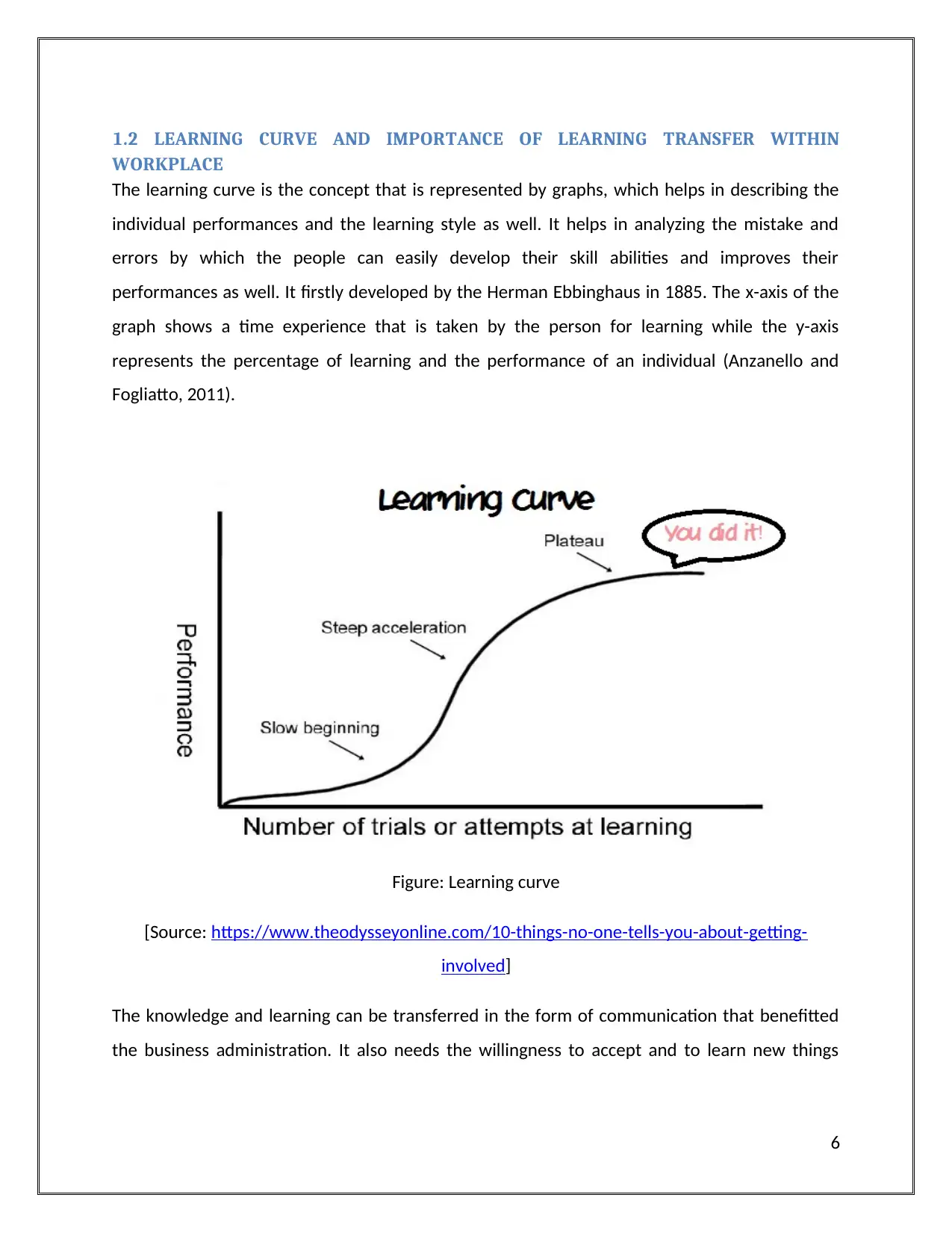
1.2 LEARNING CURVE AND IMPORTANCE OF LEARNING TRANSFER WITHIN
WORKPLACE
The learning curve is the concept that is represented by graphs, which helps in describing the
individual performances and the learning style as well. It helps in analyzing the mistake and
errors by which the people can easily develop their skill abilities and improves their
performances as well. It firstly developed by the Herman Ebbinghaus in 1885. The x-axis of the
graph shows a time experience that is taken by the person for learning while the y-axis
represents the percentage of learning and the performance of an individual (Anzanello and
Fogliatto, 2011).
Figure: Learning curve
[Source: https://www.theodysseyonline.com/10-things-no-one-tells-you-about-getting-
involved]
The knowledge and learning can be transferred in the form of communication that benefitted
the business administration. It also needs the willingness to accept and to learn new things
6
WORKPLACE
The learning curve is the concept that is represented by graphs, which helps in describing the
individual performances and the learning style as well. It helps in analyzing the mistake and
errors by which the people can easily develop their skill abilities and improves their
performances as well. It firstly developed by the Herman Ebbinghaus in 1885. The x-axis of the
graph shows a time experience that is taken by the person for learning while the y-axis
represents the percentage of learning and the performance of an individual (Anzanello and
Fogliatto, 2011).
Figure: Learning curve
[Source: https://www.theodysseyonline.com/10-things-no-one-tells-you-about-getting-
involved]
The knowledge and learning can be transferred in the form of communication that benefitted
the business administration. It also needs the willingness to accept and to learn new things
6
Paraphrase This Document
Need a fresh take? Get an instant paraphrase of this document with our AI Paraphraser
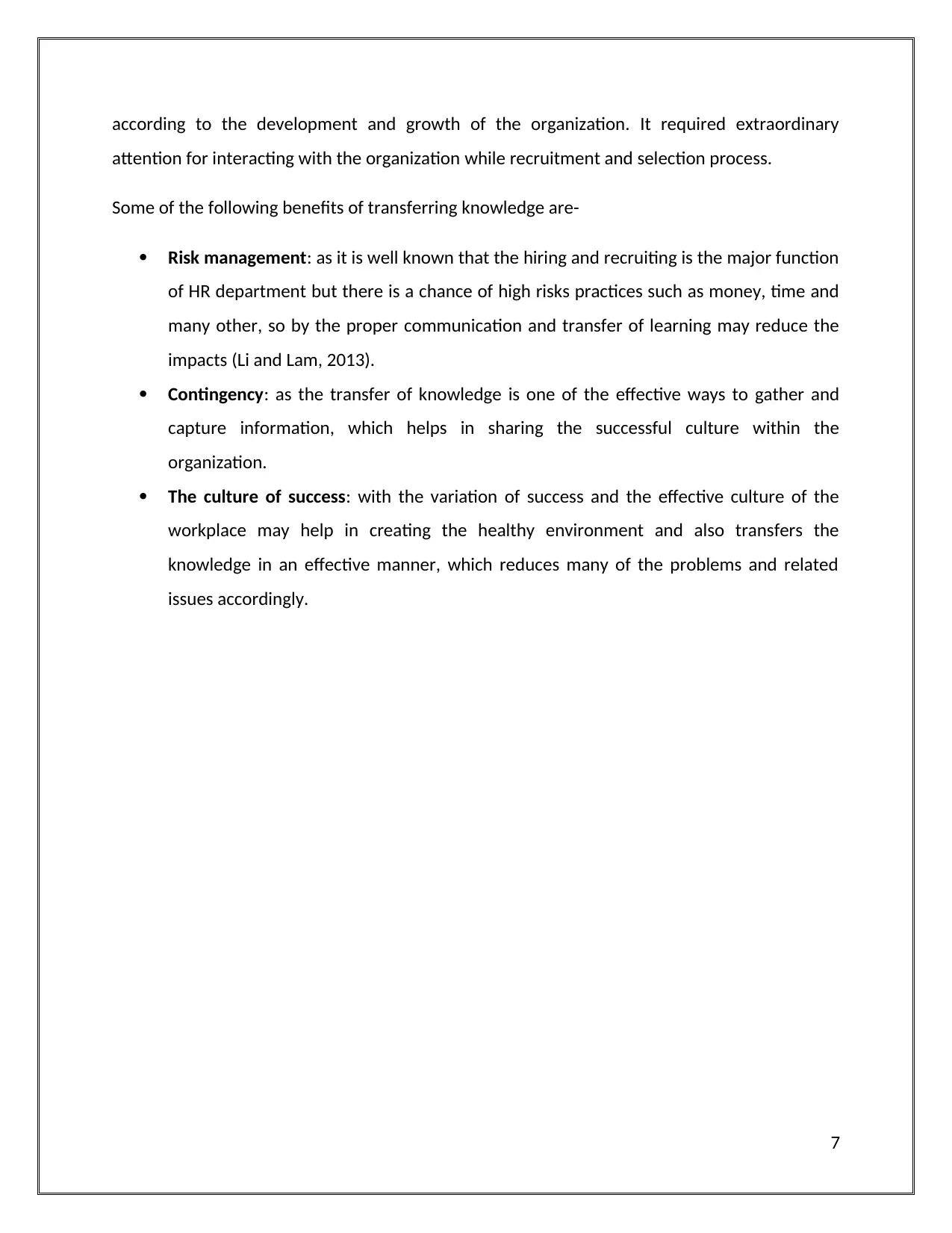
according to the development and growth of the organization. It required extraordinary
attention for interacting with the organization while recruitment and selection process.
Some of the following benefits of transferring knowledge are-
Risk management: as it is well known that the hiring and recruiting is the major function
of HR department but there is a chance of high risks practices such as money, time and
many other, so by the proper communication and transfer of learning may reduce the
impacts (Li and Lam, 2013).
Contingency: as the transfer of knowledge is one of the effective ways to gather and
capture information, which helps in sharing the successful culture within the
organization.
The culture of success: with the variation of success and the effective culture of the
workplace may help in creating the healthy environment and also transfers the
knowledge in an effective manner, which reduces many of the problems and related
issues accordingly.
7
attention for interacting with the organization while recruitment and selection process.
Some of the following benefits of transferring knowledge are-
Risk management: as it is well known that the hiring and recruiting is the major function
of HR department but there is a chance of high risks practices such as money, time and
many other, so by the proper communication and transfer of learning may reduce the
impacts (Li and Lam, 2013).
Contingency: as the transfer of knowledge is one of the effective ways to gather and
capture information, which helps in sharing the successful culture within the
organization.
The culture of success: with the variation of success and the effective culture of the
workplace may help in creating the healthy environment and also transfers the
knowledge in an effective manner, which reduces many of the problems and related
issues accordingly.
7
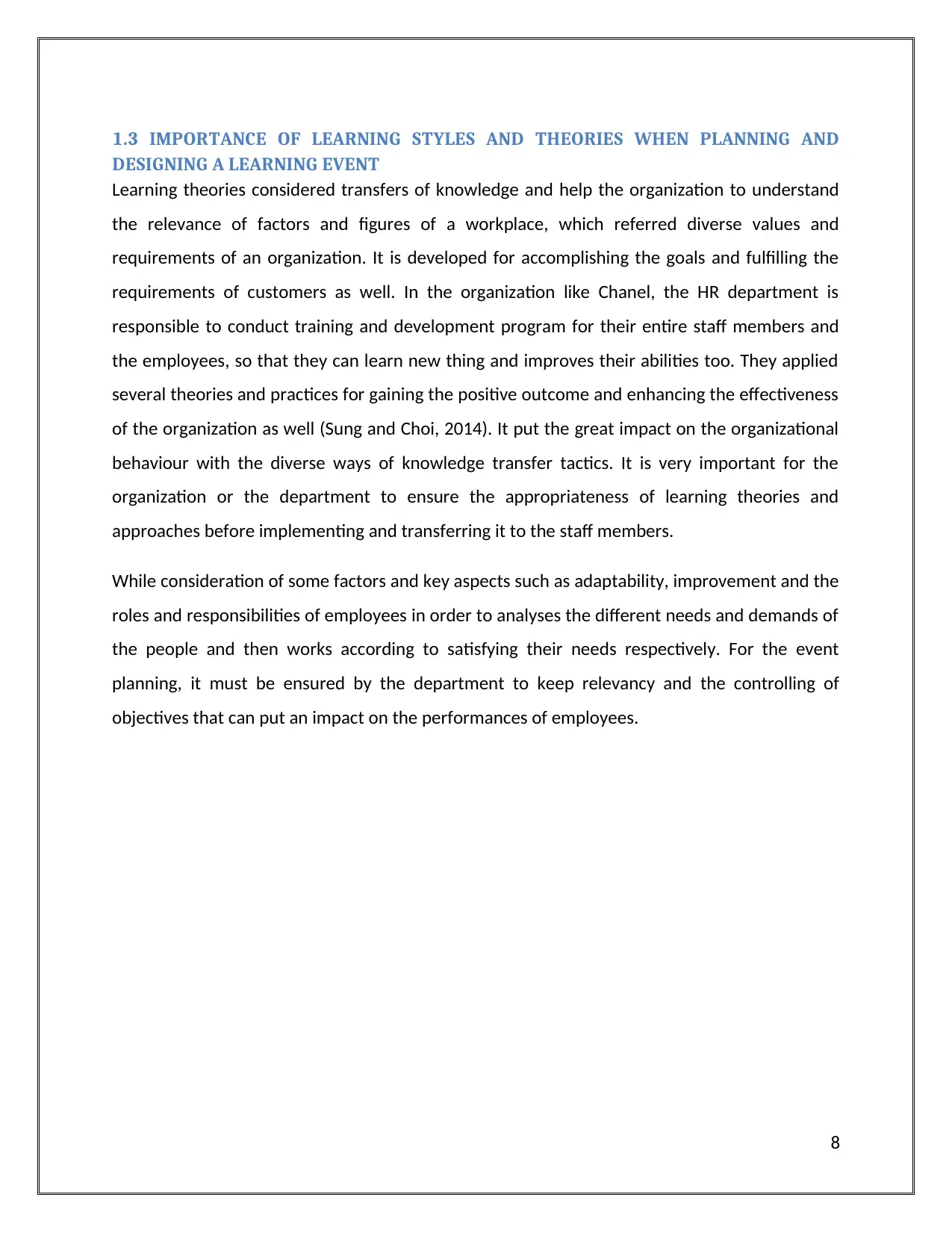
1.3 IMPORTANCE OF LEARNING STYLES AND THEORIES WHEN PLANNING AND
DESIGNING A LEARNING EVENT
Learning theories considered transfers of knowledge and help the organization to understand
the relevance of factors and figures of a workplace, which referred diverse values and
requirements of an organization. It is developed for accomplishing the goals and fulfilling the
requirements of customers as well. In the organization like Chanel, the HR department is
responsible to conduct training and development program for their entire staff members and
the employees, so that they can learn new thing and improves their abilities too. They applied
several theories and practices for gaining the positive outcome and enhancing the effectiveness
of the organization as well (Sung and Choi, 2014). It put the great impact on the organizational
behaviour with the diverse ways of knowledge transfer tactics. It is very important for the
organization or the department to ensure the appropriateness of learning theories and
approaches before implementing and transferring it to the staff members.
While consideration of some factors and key aspects such as adaptability, improvement and the
roles and responsibilities of employees in order to analyses the different needs and demands of
the people and then works according to satisfying their needs respectively. For the event
planning, it must be ensured by the department to keep relevancy and the controlling of
objectives that can put an impact on the performances of employees.
8
DESIGNING A LEARNING EVENT
Learning theories considered transfers of knowledge and help the organization to understand
the relevance of factors and figures of a workplace, which referred diverse values and
requirements of an organization. It is developed for accomplishing the goals and fulfilling the
requirements of customers as well. In the organization like Chanel, the HR department is
responsible to conduct training and development program for their entire staff members and
the employees, so that they can learn new thing and improves their abilities too. They applied
several theories and practices for gaining the positive outcome and enhancing the effectiveness
of the organization as well (Sung and Choi, 2014). It put the great impact on the organizational
behaviour with the diverse ways of knowledge transfer tactics. It is very important for the
organization or the department to ensure the appropriateness of learning theories and
approaches before implementing and transferring it to the staff members.
While consideration of some factors and key aspects such as adaptability, improvement and the
roles and responsibilities of employees in order to analyses the different needs and demands of
the people and then works according to satisfying their needs respectively. For the event
planning, it must be ensured by the department to keep relevancy and the controlling of
objectives that can put an impact on the performances of employees.
8
⊘ This is a preview!⊘
Do you want full access?
Subscribe today to unlock all pages.

Trusted by 1+ million students worldwide
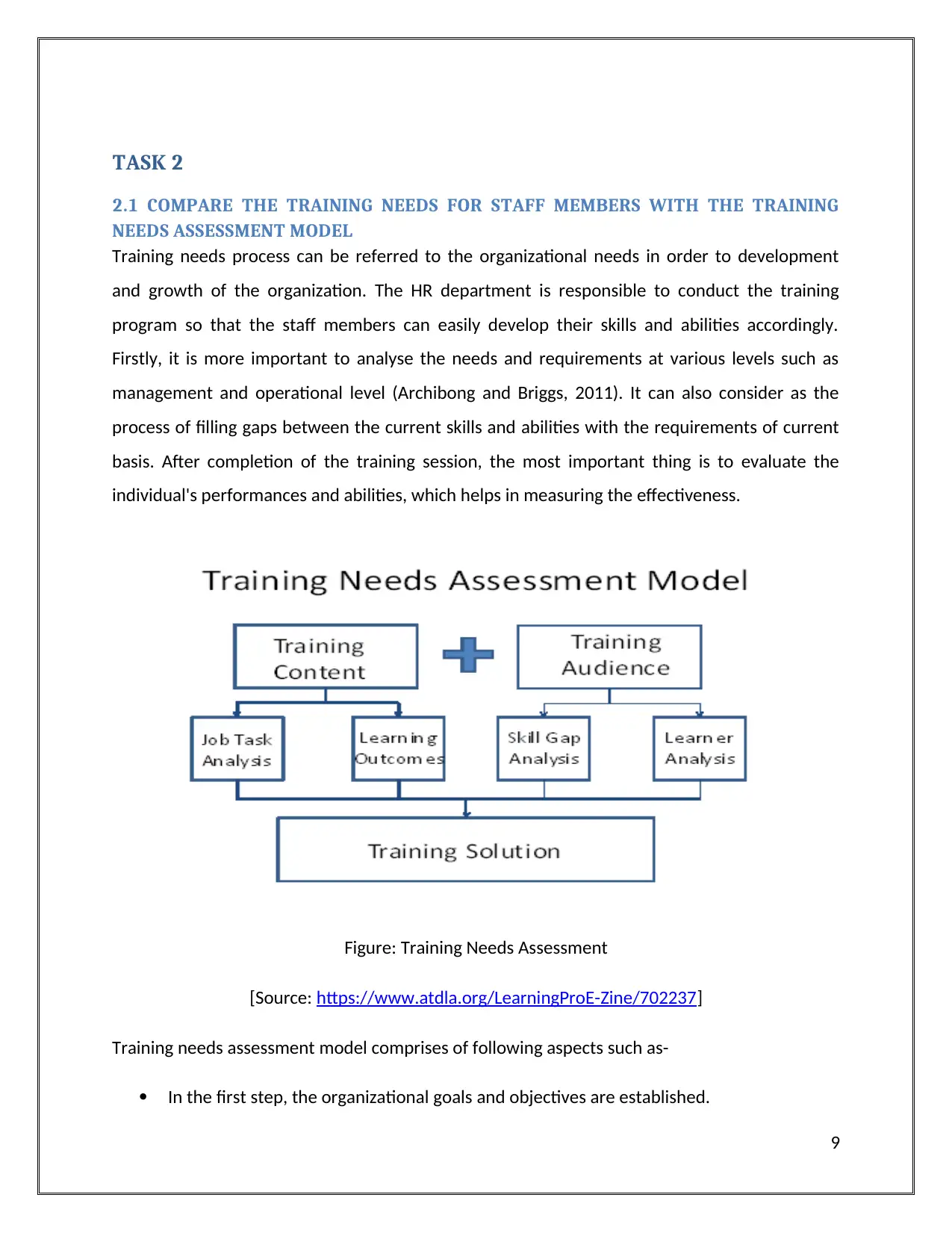
TASK 2
2.1 COMPARE THE TRAINING NEEDS FOR STAFF MEMBERS WITH THE TRAINING
NEEDS ASSESSMENT MODEL
Training needs process can be referred to the organizational needs in order to development
and growth of the organization. The HR department is responsible to conduct the training
program so that the staff members can easily develop their skills and abilities accordingly.
Firstly, it is more important to analyse the needs and requirements at various levels such as
management and operational level (Archibong and Briggs, 2011). It can also consider as the
process of filling gaps between the current skills and abilities with the requirements of current
basis. After completion of the training session, the most important thing is to evaluate the
individual's performances and abilities, which helps in measuring the effectiveness.
Figure: Training Needs Assessment
[Source: https://www.atdla.org/LearningProE-Zine/702237]
Training needs assessment model comprises of following aspects such as-
In the first step, the organizational goals and objectives are established.
9
2.1 COMPARE THE TRAINING NEEDS FOR STAFF MEMBERS WITH THE TRAINING
NEEDS ASSESSMENT MODEL
Training needs process can be referred to the organizational needs in order to development
and growth of the organization. The HR department is responsible to conduct the training
program so that the staff members can easily develop their skills and abilities accordingly.
Firstly, it is more important to analyse the needs and requirements at various levels such as
management and operational level (Archibong and Briggs, 2011). It can also consider as the
process of filling gaps between the current skills and abilities with the requirements of current
basis. After completion of the training session, the most important thing is to evaluate the
individual's performances and abilities, which helps in measuring the effectiveness.
Figure: Training Needs Assessment
[Source: https://www.atdla.org/LearningProE-Zine/702237]
Training needs assessment model comprises of following aspects such as-
In the first step, the organizational goals and objectives are established.
9
Paraphrase This Document
Need a fresh take? Get an instant paraphrase of this document with our AI Paraphraser
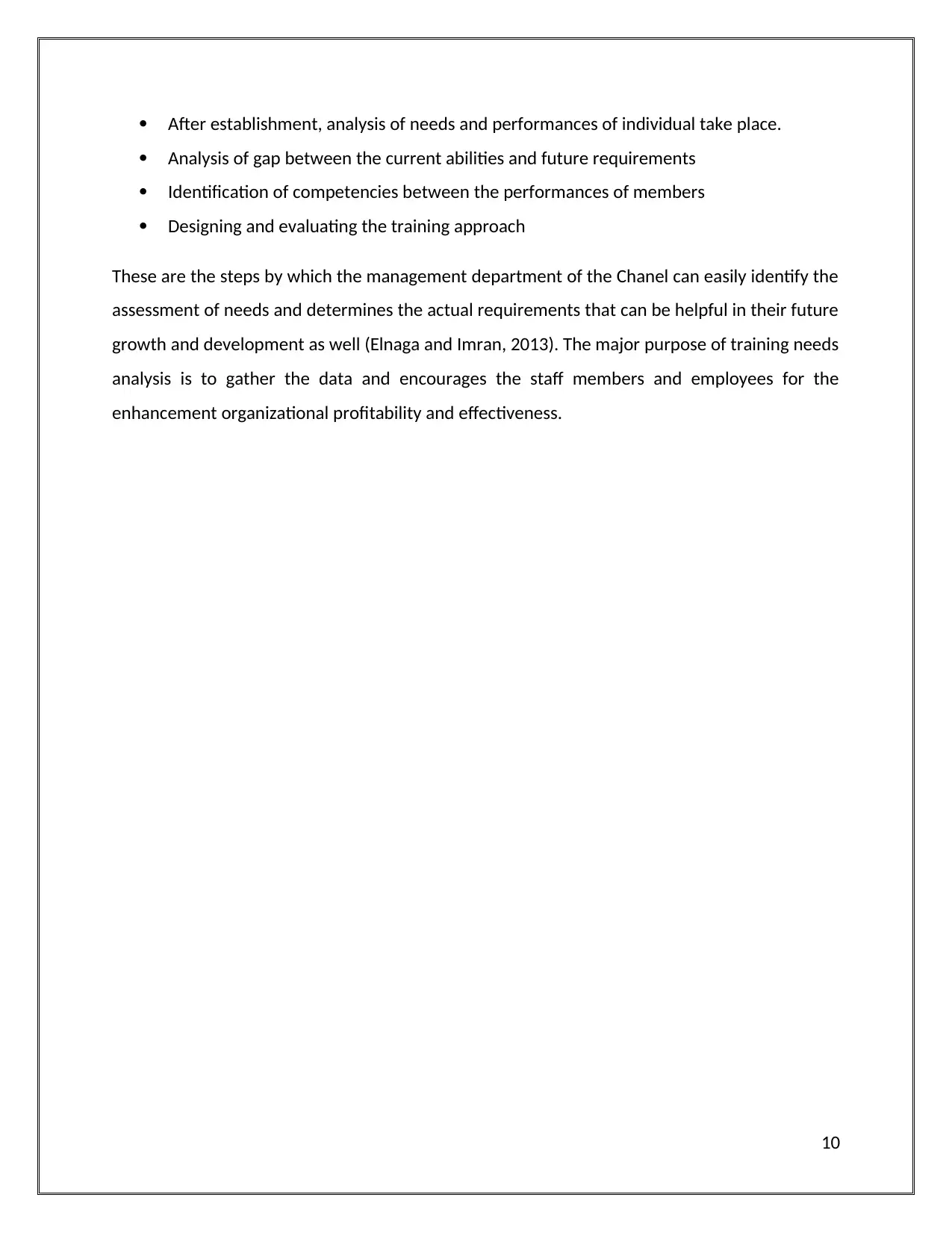
After establishment, analysis of needs and performances of individual take place.
Analysis of gap between the current abilities and future requirements
Identification of competencies between the performances of members
Designing and evaluating the training approach
These are the steps by which the management department of the Chanel can easily identify the
assessment of needs and determines the actual requirements that can be helpful in their future
growth and development as well (Elnaga and Imran, 2013). The major purpose of training needs
analysis is to gather the data and encourages the staff members and employees for the
enhancement organizational profitability and effectiveness.
10
Analysis of gap between the current abilities and future requirements
Identification of competencies between the performances of members
Designing and evaluating the training approach
These are the steps by which the management department of the Chanel can easily identify the
assessment of needs and determines the actual requirements that can be helpful in their future
growth and development as well (Elnaga and Imran, 2013). The major purpose of training needs
analysis is to gather the data and encourages the staff members and employees for the
enhancement organizational profitability and effectiveness.
10
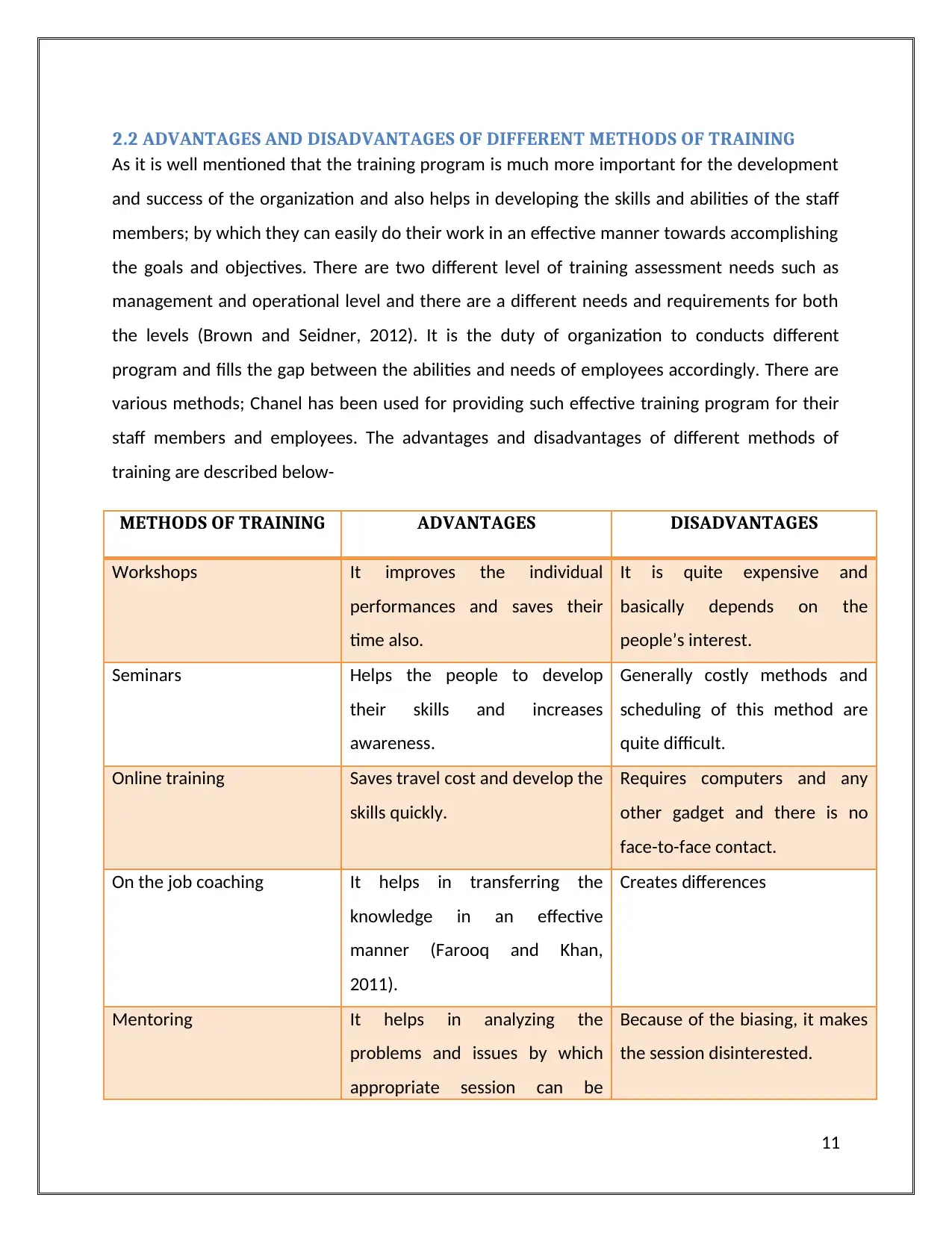
2.2 ADVANTAGES AND DISADVANTAGES OF DIFFERENT METHODS OF TRAINING
As it is well mentioned that the training program is much more important for the development
and success of the organization and also helps in developing the skills and abilities of the staff
members; by which they can easily do their work in an effective manner towards accomplishing
the goals and objectives. There are two different level of training assessment needs such as
management and operational level and there are a different needs and requirements for both
the levels (Brown and Seidner, 2012). It is the duty of organization to conducts different
program and fills the gap between the abilities and needs of employees accordingly. There are
various methods; Chanel has been used for providing such effective training program for their
staff members and employees. The advantages and disadvantages of different methods of
training are described below-
METHODS OF TRAINING ADVANTAGES DISADVANTAGES
Workshops It improves the individual
performances and saves their
time also.
It is quite expensive and
basically depends on the
people’s interest.
Seminars Helps the people to develop
their skills and increases
awareness.
Generally costly methods and
scheduling of this method are
quite difficult.
Online training Saves travel cost and develop the
skills quickly.
Requires computers and any
other gadget and there is no
face-to-face contact.
On the job coaching It helps in transferring the
knowledge in an effective
manner (Farooq and Khan,
2011).
Creates differences
Mentoring It helps in analyzing the
problems and issues by which
appropriate session can be
Because of the biasing, it makes
the session disinterested.
11
As it is well mentioned that the training program is much more important for the development
and success of the organization and also helps in developing the skills and abilities of the staff
members; by which they can easily do their work in an effective manner towards accomplishing
the goals and objectives. There are two different level of training assessment needs such as
management and operational level and there are a different needs and requirements for both
the levels (Brown and Seidner, 2012). It is the duty of organization to conducts different
program and fills the gap between the abilities and needs of employees accordingly. There are
various methods; Chanel has been used for providing such effective training program for their
staff members and employees. The advantages and disadvantages of different methods of
training are described below-
METHODS OF TRAINING ADVANTAGES DISADVANTAGES
Workshops It improves the individual
performances and saves their
time also.
It is quite expensive and
basically depends on the
people’s interest.
Seminars Helps the people to develop
their skills and increases
awareness.
Generally costly methods and
scheduling of this method are
quite difficult.
Online training Saves travel cost and develop the
skills quickly.
Requires computers and any
other gadget and there is no
face-to-face contact.
On the job coaching It helps in transferring the
knowledge in an effective
manner (Farooq and Khan,
2011).
Creates differences
Mentoring It helps in analyzing the
problems and issues by which
appropriate session can be
Because of the biasing, it makes
the session disinterested.
11
⊘ This is a preview!⊘
Do you want full access?
Subscribe today to unlock all pages.

Trusted by 1+ million students worldwide
1 out of 27
Related Documents
Your All-in-One AI-Powered Toolkit for Academic Success.
+13062052269
info@desklib.com
Available 24*7 on WhatsApp / Email
![[object Object]](/_next/static/media/star-bottom.7253800d.svg)
Unlock your academic potential
Copyright © 2020–2025 A2Z Services. All Rights Reserved. Developed and managed by ZUCOL.





